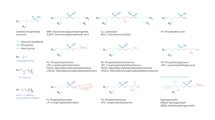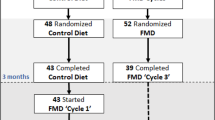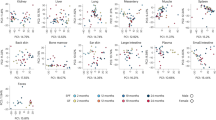Abstract
Insulin is the primary hormone involved in glucose homeostasis, and impairment of insulin action and/or secretion has a critical role in the pathogenesis of diabetes mellitus. Type-II SH2-domain-containing inositol 5-phosphatase, or ‘SHIP2’, is a member of the inositol polyphosphate 5-phosphatase family1. In vitro studies have shown that SHIP2, in response to stimulation by numerous growth factors and insulin, is closely linked to signalling events mediated by both phosphoinositide-3-OH kinase and Ras/mitogen-activated protein kinase2,3,4,5. Here we report the generation of mice lacking the SHIP2 gene. Loss of SHIP2 leads to increased sensitivity to insulin, which is characterized by severe neonatal hypoglycaemia, deregulated expression of the genes involved in gluconeogenesis, and perinatal death. Adult mice that are heterozygous for the SHIP2 mutation have increased glucose tolerance and insulin sensitivity associated with an increased recruitment of the GLUT4 glucose transporter and increased glycogen synthesis in skeletal muscles. Our results show that SHIP2 is a potent negative regulator of insulin signalling and insulin sensitivity in vivo.
This is a preview of subscription content, access via your institution
Access options
Subscribe to this journal
Receive 51 print issues and online access
$199.00 per year
only $3.90 per issue
Buy this article
- Purchase on Springer Link
- Instant access to full article PDF
Prices may be subject to local taxes which are calculated during checkout



Similar content being viewed by others
References
Pesesse, X., Deleu, S., De Smedt, F., Drayer, L. & Erneux, C. Identification of a second SH2-domain-containing protein closely related to the phosphatidylinositol polyphosphate 5-phosphatase SHIP. Biochem. Biophys. Res. Commun. 239, 697 –700 (1997).
Habib, T., Hejna, J. A., Moses, R. E. & Decker, S. J. Growth factors and insulin stimulate tyrosine phosphorylation of the 51C/SHIP2 protein. J. Biol. Chem. 273, 18605– 18609 (1998).
Pesesse, X. et al. The SH2 domain containing inositol 5-phosphatase SHIP2 displays phosphatidylinositol 3,4,5-triphosphate and inositol 1,3,4,5-tetrakisphosphate 5-phosphatase activity. FEBS Lett. 437, 301–303 (1998).
Wisniewski, D. et al. A novel SH2-containing phosphatidylinositol 3,4,5-triphosphate 5-phosphatase (SHIP2) is constitutively tyrosine phosphorylated and associated with src homologous and collagen gene (SHC) in chronic myelogenous leukemia progenitor cells. Blood 93, 2707– 2720 (1999).
Ishihara, H. et al. Molecular cloning of rat SH2-containing inositol phosphatase 2 (SHIP2) and its role in the regulation of insulin signaling. Biochem. Biophys. Res. Commun. 260, 265– 272 (1999).
Schurmans, S. et al. The mouse SHIP2 (Inppl1) gene: complementary DNA, genomic structure, promoter analysis, and gene expression in the embryo and adult mouse. Genomics 62, 260– 271 (1999).
Liu, Q. et al. The SH2-containing inositol polyphosphate 5-phosphatase, SHIP, is expressed during hematopoiesis and spermatogenesis. Blood 91, 2753–2759 (1998).
Lteif, A. N. & Schwenk, W. F. Hypoglycemia in infants and children. Endocrinol. Metab. Clin. North Am. 28, 619–646 (1999).
Girard, J., Ferré, P., Pégorier, J.-P. & Duée, P.-H. Adaptations of glucose and fatty acid metabolism during perinatal period and suckling-weaning transition. Physiol. Rev. 72, 507–562 (1992).
Girard, J. & Pégorier, J.-P. An overview of early post-partum nutrition and metabolism. Biochem. Soc. Trans. 26, 69–74 (1998).
Jones, C. T. (ed) The Development of the Metabolism in the Fetal Liver (Elsevier Biomedical Press, Elsevier, 1982).
Girard, J., Caquet, D., Bal, D. & Guillet, I. Control of rat liver phosphorylase, glucose-6-phosphatase and phosphoenolpyruvate carboxykinase activities by insulin and glucagon during the perinatal period. Enzyme 15, 272–285 ( 1973).
Yeung, D. & Oliver, I. T. Factors affecting the premature induction of phosphoenolpyruvate carboxykinase in neonatal rat liver. Biochem. J. 108, 325–331 (1968).
Hanson, R. W., Fisher, L., Ballard, F. J. & Reshef, L. The regulation of phosphoenolpyruvate carboxykinase in fetal rat liver. Enzyme 15, 97–100 ( 1973).
Benvenisty, N. et al. in Lessons from Animal Diabetes (eds Shafrir, E. A. & Renold, A. E.) 717–733 (Libbey, London, 1984).
Czech, M. & Corvera, S. Signaling mechanisms that regulate glucose transport. J. Biol. Chem. 274, 1865 –1868 (1999).
Nave, B. T. et al. Compartment-specific regulation of phosphoinositide 3-kinase by platelet-derived growth factor and insulin in 3T3-L1 adipocytes. Biochem. J. 318, 55–60 ( 1996).
Corvera, S. & Czech, M. P. Direct targets of phosphoinositide 3-kinase products in membrane traffic and signal transduction. Trends Cell Biol. 8, 442–446 (1998).
Warram, J. H., Rich, S. S. & Krolewski, A. S. in Joslin's Diabetes Mellitus (eds Kahn, C. R. & Weir, G. C.) 201–216 (Lea and Febiger, Philadelphia, 1995).
Kahn, B. Type 2 diabetes: when insulin secretion fails to compensate for insulin resistance. Cell 92, 593–596 (1998).
Lee, Y.-H., Sauer, B., Johnson, P. F. & Gonzalez, F. J. Disruption of the C/EBPα gene in adult mouse liver. Mol. Cell. Biol. 17, 6014–6022 (1997).
Bruyns, C., Pesesse, X., Moreau, C., Blero, D. & Erneux, C. The two SH2-domain-containing inositol 5-phosphatases SHIP1 and SHIP2 are coexpressed in human T lymphocytes. Biol. Chem. 380, 969–974 ( 1999).
Simpson, I. A. et al. Insulin-stimulated translocation of glucose transporters in the isolated rat adipose cells. Biochim. Biophys. Acta 763, 393–407 (1983).
Higaki, Y. et al. Insulin receptor substrate-2 is not necessary for insulin- and exercice-stimulated glucose transport in skeletal muscle. J. Biol. Chem. 274, 20791–20795 (1999).
Stenbit, A. E. et al. Diverse effects of Glut 4 ablation on glucose uptake and glycogen synthesis in red and white skeletal muscle. J. Clin. Invest. 98, 629–634 (1996).
Acknowledgements
We thank B. Payrastre, G. Giuriato, and J. and R. Merino for sharing unpublished results; E. Marion, T. Grémeaux and L. Maisin for technical assistance; A. Nagy for the R1 ES cells; P. Johnson for rat C/EBPβ cDNA clone; and G. Schütz for mouse TAT-5′, G-6-Pase, C/EBPα and aldolase B cDNA clones. This work and U.K. were supported by the Belgian Programme on Interuniversity Poles of Attraction initiated by the Belgian State, Prime Minister's Office, Federal Service for Science, Technology and Culture, the Fonds de la Recherche Scientifique Médicale de Belgique, Biomed 2 program, Association contre le Cancer, and Télévie. S.C. is a fellow of the FRIA; F.D. and S.S. are Chargé de Recherche and Chercheur Qualifié of the Belgian FNRS, respectively. J.B. was supported by the Deutsche Forschungsgemeinschaft. Y.L.M.B. and J.F.T. are supported by Institut National de la Santé et de la Recherche Médicale (France).
Author information
Authors and Affiliations
Corresponding author
Supplementary information
Rights and permissions
About this article
Cite this article
Clément, S., Krause, U., Desmedt, F. et al. The lipid phosphatase SHIP2 controls insulin sensitivity. Nature 409, 92–97 (2001). https://doi.org/10.1038/35051094
Received:
Accepted:
Issue Date:
DOI: https://doi.org/10.1038/35051094
This article is cited by
-
Phosphoinositides and intracellular calcium signaling: novel insights into phosphoinositides and calcium coupling as negative regulators of cellular signaling
Experimental & Molecular Medicine (2023)
-
The manifold roles of protein S-nitrosylation in the life of insulin
Nature Reviews Endocrinology (2022)
-
An auxiliary binding interface of SHIP2-SH2 for Y292-phosphorylated FcγRIIB reveals diverse recognition mechanisms for tyrosine-phosphorylated receptors involved in different cell signaling pathways
Analytical and Bioanalytical Chemistry (2022)
-
Biochemical and cellular properties of insulin receptor signalling
Nature Reviews Molecular Cell Biology (2018)
-
Biofluid lipidome: a source for potential diagnostic biomarkers
Clinical and Translational Medicine (2017)
Comments
By submitting a comment you agree to abide by our Terms and Community Guidelines. If you find something abusive or that does not comply with our terms or guidelines please flag it as inappropriate.



